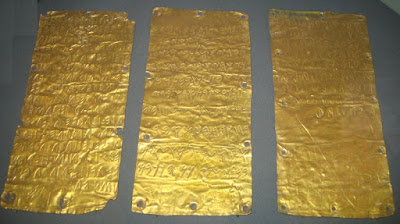However, the many porticoes and courtyards and so on were designed by others, including Giorgio Vasari.
These days the villa is the Museo Nazionale Etrusco, that is, the National Etruscan Museum. It houses an amazing array of Etruscan artifacts and Greek artifacts recovered from Etruscan tombs. This is the Apollo of Veii, a painted terracotta Etruscan statue of Apollo discovered in the Portonaccio sanctuary of ancient Veii. It dates from c. 510 - 500 BC. It was probably made by Vulca, the only Etruscan artist whose name is known.
The golden tablets of Pyrgi, which contain a bilingual inscription in Etruscan and Phoenician, one of the most important clues in the still incomplete decipherment of the Etruscan language.
The famous Sarcophagus of the Spouses.
The Chigi Vase, a Greek vessel with one of the best surviving depictions of early classical hoplites in battle.
The Euphronios Krater. This signed masterwork of the painter Euphronios was purchased by the Met in 1972, despite doubts as to whether the provenance produced for it was genuine. Then in 2006, during the trial of Italian antiquities dealer Giacomo Medici, evidence was introduced showing that the vessel was looted from an Etruscan tomb in 1971. So the Met sent it back to Italy in 2008, as part of a deal that included long-term loans to the Met of other objects. This scene shows the death of the hero Sarpedon; Hermes directs Death and Sleep in carrying away the body.
Out behind the villa is this remarkable little gem, the reconstruction of a small Etruscan temple. It was built in 1891 by Count Adolfo Cozza, who based the design on excavations made in the 19th century and on a description by the Roman writer Vitruvius.
Details.
View inside, showing that it is used as a sort of storage space for second-line artifacts. I encountered this many times in Greece; step around a corner at the back of the museum and you find a yard full of columns and other pieces of architectural sculpture, just sort of sitting there.

















No comments:
Post a Comment